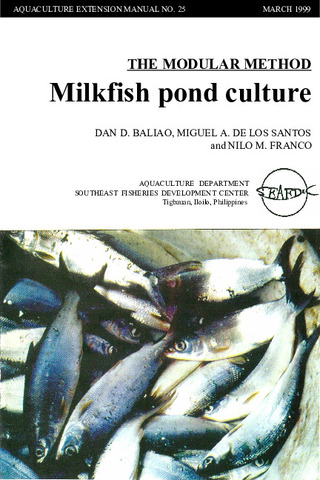Survival of captive milkfish Chanos chanos Forsskal broodstock subjected to handling and transport
| dc.contributor.author | Garcia, Luis Maria | |
| dc.contributor.author | Hilomen-Garcia, G. V. | |
| dc.contributor.author | Emata, Arnil C. | |
| dc.date.accessioned | 2014-01-10T06:27:20Z | |
| dc.date.available | 2014-01-10T06:27:20Z | |
| dc.date.issued | 2000 | |
| dc.identifier.citation | Garcia, L. M. B., Hilomen-Garcia, G. V., & Emata, A. C. (2000). Survival of captive milkfish Chanos chanos Forsskal broodstock subjected to handling and transport. Aquaculture Research, 31(7), 575-583. | en |
| dc.identifier.issn | 1355-557X | |
| dc.identifier.uri | http://hdl.handle.net/10862/1873 | |
| dc.description.abstract | The survival of milkfish broodstock (body weight range 1–11 kg) was determined until 30 days after handling and transport in open tanks or in sealed oxygenated bags containing chilled sea water (20–25 °C). Maintenance of cool sea water was achieved by the gradual addition of ice chunks or frozen gel packs. A survival rate of 50% after transporting fish at a loading density of 45 kg m−3 for 4 h in open tanks was not significantly different from those that were handled but not transported (86%). Similarly, survival rates (67–83%) among broodstock confined for 8 h in chilled sea water at 40 and 60 kg m−3 were not significantly different from each other or from a group not subjected to confinement. Nevertheless, low dissolved oxygen (DO) and accumulation of total ammonia–nitrogen beginning 1 h after transport and confinement may be responsible for low survival rates of milkfish in open tanks. In contrast, all milkfish survived 10 h of overland transport in sealed bags with chilled and diluted (28 g L−1) sea water. Likewise, all milkfish survived after being bagged and immediately transferred to a communal rearing tank, or bagged and placed in a styrofoam box for 10 h. Except for total ammonia–nitrogen levels, which increased slightly (0.7–0.8 mg L−1) above background, seawater temperature (20–24 °C), salinity (28 g L−1) and DO (6 to > 20 mg mL−1) titres in transport bags were maintained during the 10-h test. The effectiveness of handling and transporting milkfish broodstock in sealed bags containing chilled sea water was verified in actual field trials. Spawning of sexually mature milkfish subjected to these stressors was not impaired. These results demonstrate that mortalities of large milkfish broodstock can be minimized when fish are handled and transported in sealed oxygenated bags containing chilled sea water. | en |
| dc.description.sponsorship | The assistance of staff at the Igang Marine Substation and the Big Hatchery in Tigbauan is acknowledged. Additional assistance was provided by Editha Panes, Pastor Denusta, Sherlito Balacanta, Fernando Sarmiento, Tomas Gonzalez, who also drew the figures, and the crew of M/B Rosary II and M/B Juracell. Study code Br-06-F96T. | en |
| dc.language.iso | en | en |
| dc.publisher | Wiley-Blackwell | en |
| dc.subject | milkfish | en |
| dc.subject | Chanos chanos | en |
| dc.title | Survival of captive milkfish Chanos chanos Forsskal broodstock subjected to handling and transport | en |
| dc.type | Article | en |
| dc.identifier.doi | 10.1046/j.1365-2109.2000.00475.x | |
| dc.citation.volume | 31 | |
| dc.citation.issue | 7 | |
| dc.citation.spage | 575 | |
| dc.citation.epage | 583 | |
| dc.citation.journalTitle | Aquaculture Research | en |
| seafdecaqd.library.callnumber | VF SJ 0634 | |
| seafdecaqd.databank.controlnumber | 2000-14 | |
| dc.subject.asfa | aquaculture techniques | en |
| dc.subject.asfa | stress | en |
| dc.subject.asfa | fish culture | en |
| dc.subject.asfa | handling | en |
| dc.subject.asfa | mortality causes | en |
| dc.subject.asfa | transport | en |
| dc.subject.scientificName | Chanos chanos |
Files in this item
| Files | Size | Format | View |
|---|---|---|---|
|
There are no files associated with this item. |
|||
This item appears in the following Collection(s)
-
Journal Articles [1256]
These papers were contributed by Department staff to various national and international journals.



